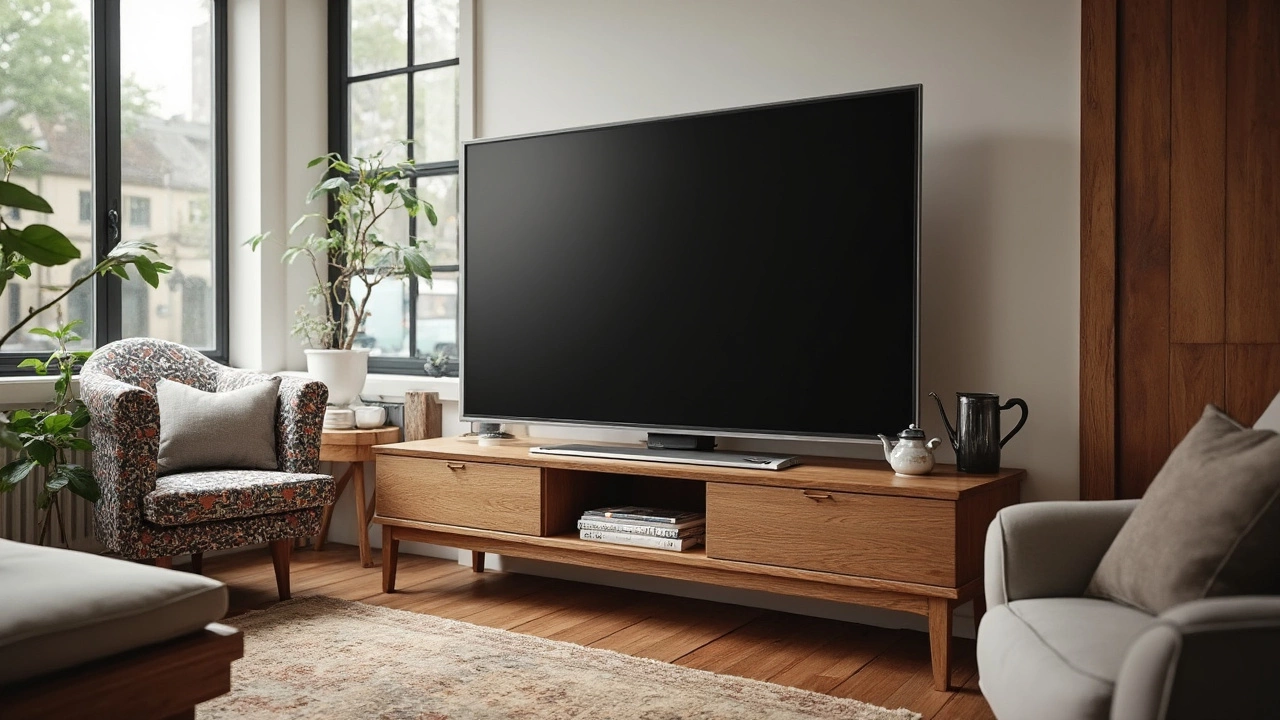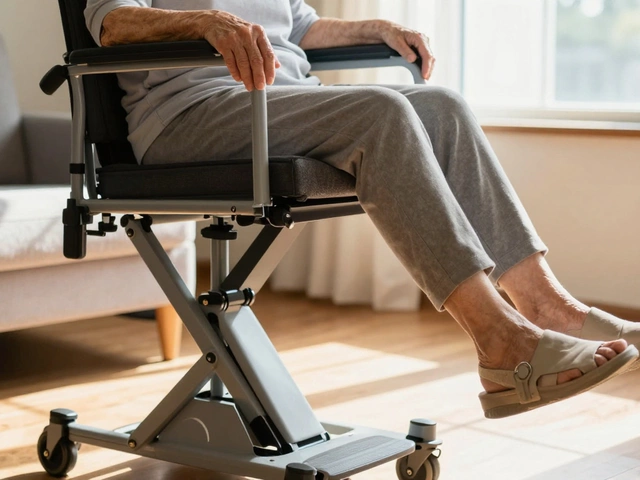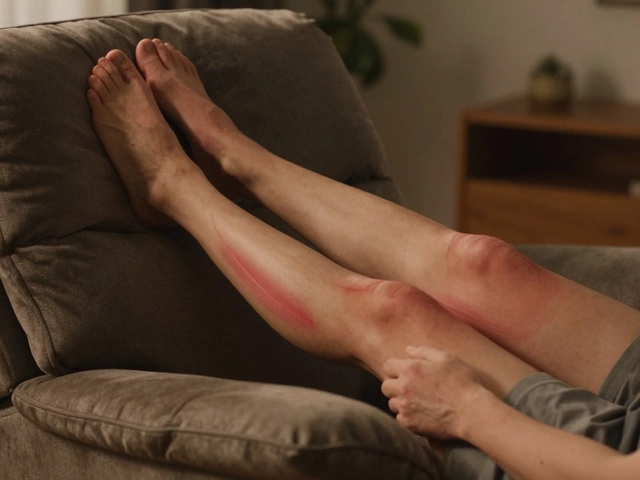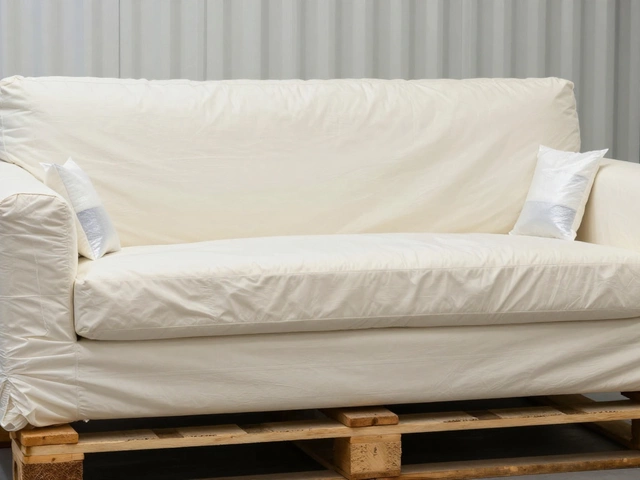Picture this: you finally bought that giant TV, but your stand looks like a sad little diving board underneath it. Is that a big deal? Actually, yeah—it’s about more than just an awkward look. The risk of your TV tipping over spikes if your screen hangs way past the ends of the stand. According to home safety experts, TVs that aren’t properly supported cause thousands of injuries every year. Not great, right?
It’s not just about safety, either. When your TV is a foot wider than your stand, you get this lopsided vibe that makes your whole setup feel off. Guests notice, you notice, and the space just feels cramped and kind of chaotic. But hey, if you’re dealing with a tiny living room or inherited furniture, sometimes you have to work with what you’ve got. So how do you strike a balance between safety, style, and what actually fits your life? Let’s break it down with what actually works—not what some random Pinterest post claims.
- What's the Problem with an Oversized TV?
- A Safe Setup: What the Pros Suggest
- Looks Matter: Pulling Off a Balanced Space
- Tricks for Odd Setups and Small Rooms
- When to Break the Rules
What's the Problem with an Oversized TV?
If your TV is way bigger than your TV stand, you're basically inviting problems into your living room—starting with safety. When a TV's base isn't fully supported, there's a real risk it could tip over, especially if you've got kids running around or pets jumping on furniture. The American Academy of Pediatrics reports that about 17,000 kids in the U.S. are injured each year from TV tip-overs. That's a stat nobody wants to be part of.
There's a style factor too. If you care about how your setup looks, a huge screen balanced on a small stand just screams "unfinished project." It can mess up the room’s balance and make your living area look off, no matter how modern or expensive your actual TV is. Plus, exposed TV edges are begging to get bumped or scratched.
The most important thing when picking your TV stand is making sure it's the right size for your screen. Here's what usually happens when the TV is wider than the furniture holding it:
- Risk of tipping increases with every inch the screen hangs off the edge.
- All those fancy cable ports are harder to reach or organize because you’ll want to push the stand further back against the wall.
- Remote sensors might get blocked, or you lose good angles for comfy viewing.
A quick glance at the numbers below shows why sizing matters. The risk of TV injuries really jumps when screens aren’t supported properly:
| TV Tip-Over Injuries (US, 2023) | TV Fit with Stand |
|---|---|
| 17,000 | Often too large for stand |
| 1,500 | Proper fit with stand |
So, being honest—if your TV dwarfs your stand, it's time to rethink your setup. Safety, looks, and convenience all take a hit when you ignore the basics.
A Safe Setup: What the Pros Suggest
So, what’s the gold standard for TV placement? Most home safety experts and interior designers agree your TV stand should be at least as wide as—or a little wider than—your TV. Ideally, the stand should extend 2-6 inches beyond the TV edges on each side. That extra width keeps your screen steady, especially if someone bumps into the furniture or if the kids get a little wild during movie night.
Tip: A 55-inch TV is actually about 48 inches wide (the “55” is diagonal), so check your TV's actual width and not just the listed size. Always measure before grabbing a new stand or mounting your TV. Don’t trust a rough guess.
Here’s what pros usually tell you to look for in a safe setup:
- Make sure your stand can hold both the weight and width of the TV. Check the weight limit in your stand’s manual—seriously, those numbers exist for a reason.
- Level surface: TV stands should be sturdy and not wobbly. Cheap, lightweight stands can sag over time or even tip.
- Anchor it: If you have small kids or rowdy pets, consider wall-anchoring the TV or stand. A $15 safety strap can save thousands in damage or worse.
- Keep cables tidy: Trailing cords create tripping hazards, which ups the odds someone accidentally bumps (or yanks) the TV.
The bottom line: putting a huge screen on a tiny stand is setting yourself up for an accident. Play it safe and measure before you buy—it’s worth the few extra minutes.
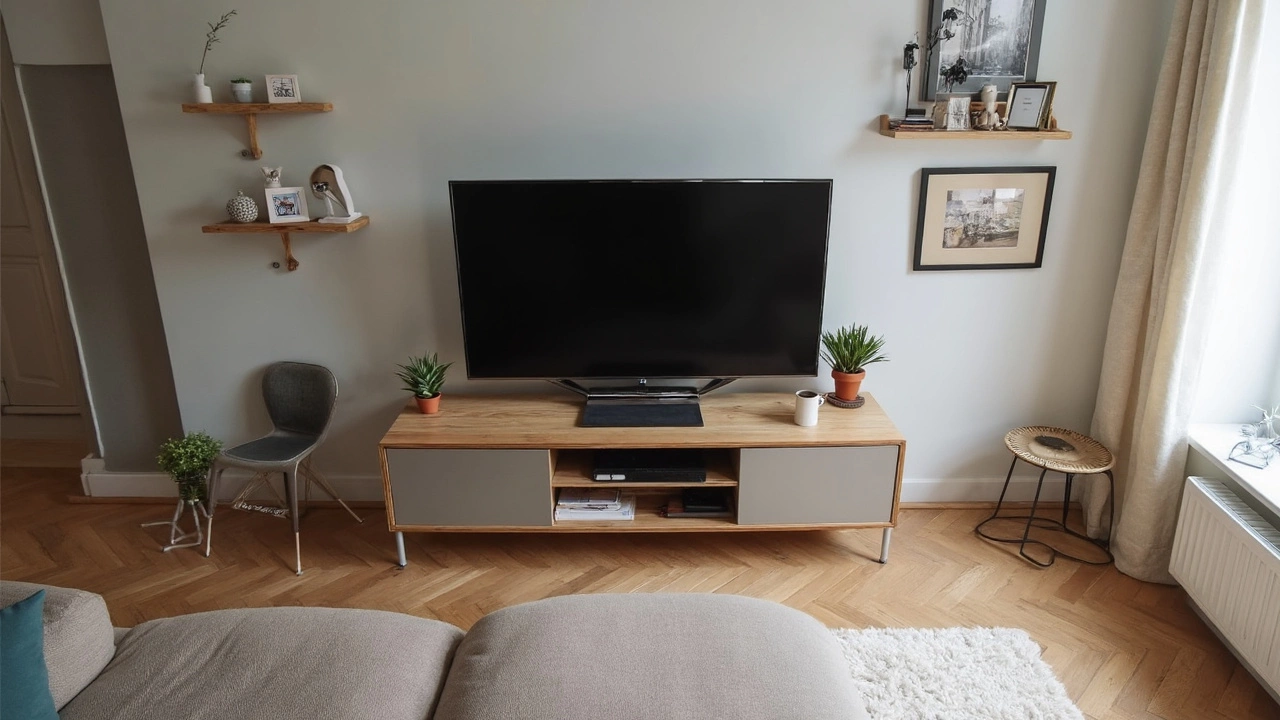
Looks Matter: Pulling Off a Balanced Space
Visual balance is a big deal in any room, but nowhere is it more obvious than with your TV setup. If your TV is way wider than your TV stand, it can throw off the whole vibe—even if you’ve nailed everything else. People notice, trust me. Designers usually suggest that your stand should at least match the width of your TV, or even stick out an inch or two on each side for a frame-like look.
Why? When the TV overhangs, it just looks top-heavy. It breaks up clean lines in your living room and it sometimes makes everything else—decor, speakers, even your console—seem out of place. Here are some tips that actually work to keep things looking sharp:
- Stick to the rule of thirds. Your TV and stand should visually fill about two-thirds of the wall behind them. Too small, and everything looks lost. Too big, and it can swallow up the space.
- Symmetry is your friend. If you can, center your TV and TV stand on the wall or relative to your main seating area. Floating shelves or pairs of speakers on either side help pull the whole thing together.
- Think about color and material. If your TV stand is darker and blends in with the TV, it’ll help the setup look more streamlined, even if things aren’t a perfect fit. Glass or metal stands can also “lighten up” the look of a wide TV.
- Give your gadgets a home. Stands with open shelves or closed cabinets keep clutter out of sight. Messy wires, random remotes, and piles of game cases can make even the best setups look unfinished.
Don't forget lighting. Even a simple strip of LED lights behind your TV or under the stand can smooth out harsh contrasts and make everything look more polished. At the end of the day, you want your whole setup to look intentional—not like you just upgraded the TV and hoped for the best.
Tricks for Odd Setups and Small Rooms
Got a cramped living room or a TV stand that’s way shorter than the screen you just unpacked? You’re definitely not alone—about 34% of apartments in cities are under 600 square feet, and most come with layout problems. But that doesn't mean your setup has to look or feel awkward.
If your TV stand is smaller than your TV, your first step is all about stability. Don’t just hope it stays put. Use anti-tip straps—there are no-drill options that anchor your TV right to the wall. That cuts the tip-over risk to almost zero. A Wall Street Journal survey found more than half of renters use these in tight spaces.
If wall-mounting is possible, go for it. That frees up the stand for consoles, speakers, or storage baskets, and keeps your entertainment area from swallowing up the whole room. If you rent and can’t drill holes, look into a universal floor TV stand—they’re sturdy and fit flush against the wall, even in the tiniest spaces.
- Slide a slim shelf right under the TV if you need extra room for remotes or game controllers.
- Use cord management tools, like adhesive clips or fabric sleeves. It stops cable spaghetti, which makes any setup look smaller and messier than it is.
- Choose light-colored or glass stands, which bounce light around and make even dark corners feel a bit bigger.
- Swap bulky soundbars for compact wireless speakers. Mount them next to the TV or tuck them on floating shelves.
Here’s a quick look at common challenges and the easiest fixes people actually use:
| Problem | Quick Fix |
|---|---|
| Stand is too short for TV | Secure TV with safety straps or wall-mount it |
| No room for devices | Add floating shelves above or beside TV |
| Messy cables | Use adhesive cable organizers |
| Small space feels cluttered | Pick a glass or open-frame stand for less visual weight |
When you mix smart furniture choices with a little creativity, you can squeeze a lot more function (and style) out of a weird setup or a tiny TV corner. The key is thinking vertical and picking gear that multitasks without hogging space.

When to Break the Rules
Sometimes, sticking to every guideline is just not realistic. Maybe you scored that massive TV on sale but can’t shell out for a new, wider stand. Or maybe your apartment is so tiny that only a slim stand fits. You’re not doomed—you just need to get smart and a little creative.
If you really want your TV to be wider than the stand, the most important thing is safety. Anchor that TV. Most modern flatscreens come with mounting holes in the back. Grab an anti-tip strap kit for about twenty bucks online—secure one end to your TV, the other to a stud in the wall. This is non-negotiable if you’ve got pets or kids, but honestly, it’s just smart for everyone. The Consumer Product Safety Commission says tip-overs send an average of 15,600 people to the ER a year in the U.S.
- Wall-mount the TV if possible, then use your stand just for storage or decor. This gets rid of the tipping issue entirely.
- If you have to set the TV on the stand and it sticks out, center it as best you can and push the stand against the wall for more back support.
- Don’t load heavy stuff (like giant soundbars or gaming consoles) on the ends that overhang—keep it balanced.
Wondering if it looks weird? Interior designers sometimes break this so-called "rule" on purpose—especially with ultra-minimal stands that make the TV look like it’s floating. Plus, for huge rooms or open-plan spaces, a wide TV can actually help zone your living area and draw focus where you want it.
| TV Size | Recommended Stand Width | When You Can Go Smaller |
|---|---|---|
| 55" | At least 48" | If wall-mounted or securely strapped |
| 65" | At least 57" | If anchoring and centering is possible |
| 75"+ | At least 67" | If stand is against wall, and anti-tip in place |
Bottom line: As long as you use some common sense—anchoring, centering, and not overloading—a TV that’s bigger than your TV stand can still work. Just don’t skip the safety stuff.

